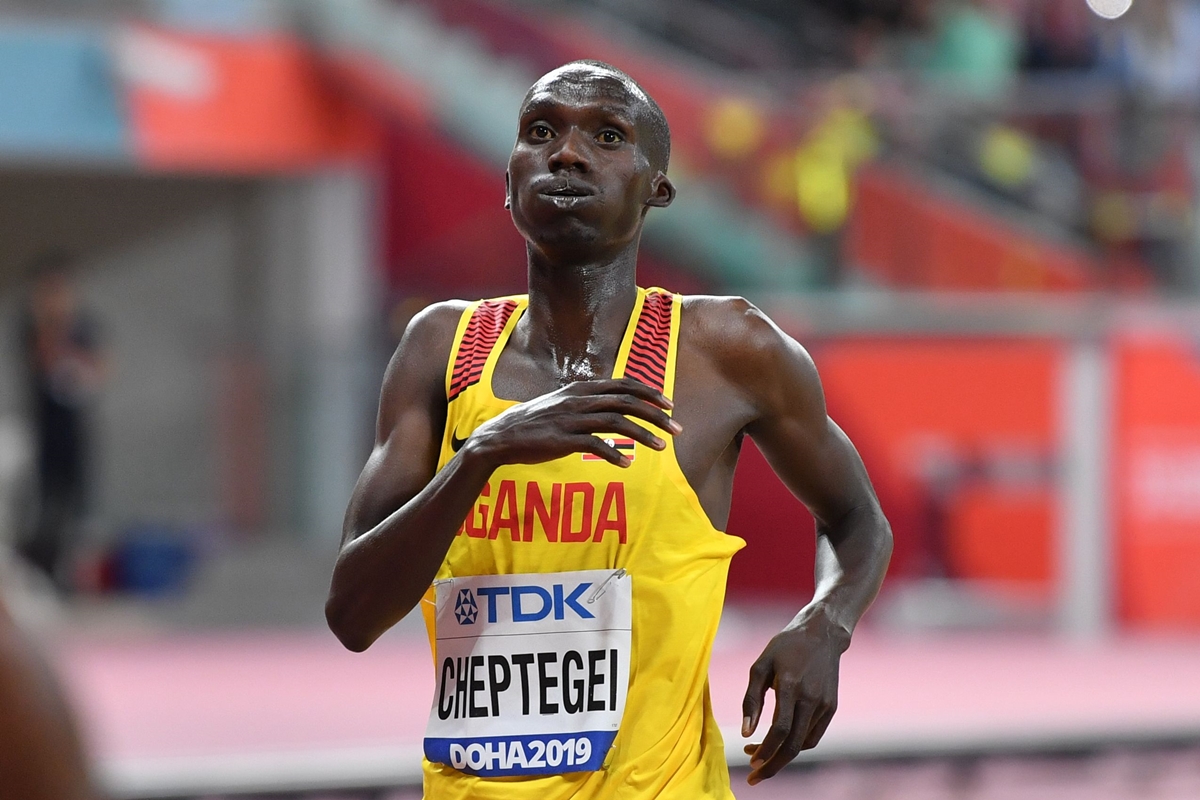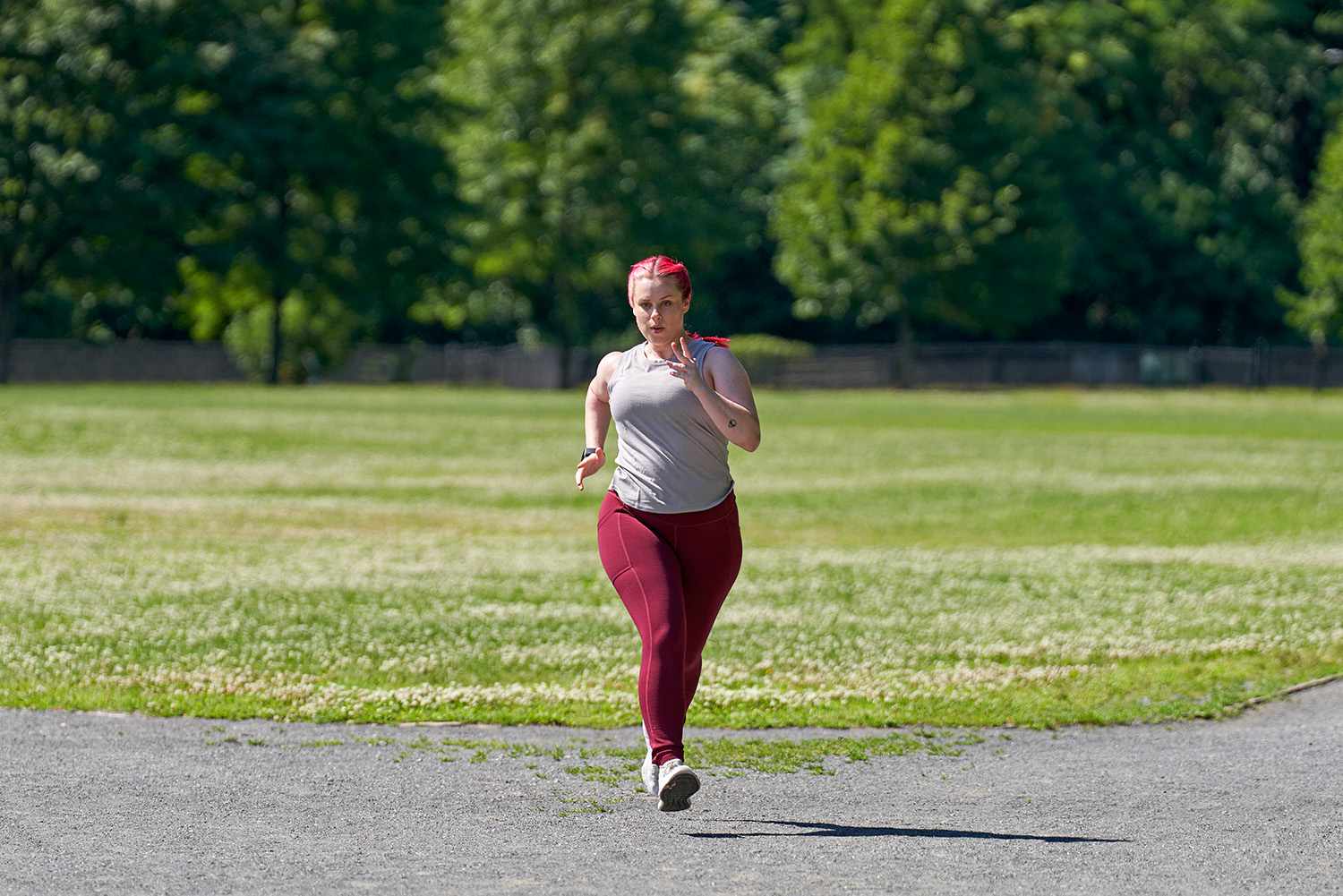

Featured
How To Train Kids For A 5K Run
Modified: January 22, 2024
Get your kids active and healthy with our featured guide on how to train them for a 5K run. Engage them in a fun and rewarding fitness journey today!
Introduction
Welcome to the exciting world of running! Training for a 5K run can be a rewarding and empowering experience, especially for kids. Engaging in physical activity from a young age not only promotes a healthy lifestyle, but also teaches important life skills such as discipline, goal-setting, and perseverance. Whether your child is a seasoned runner or new to the sport, this article will provide valuable insights on how to train kids for a 5K run.
Participating in a 5K race can seem intimidating at first, but with the right training program, guidance, and support, your child can conquer this challenge and cross the finish line with a sense of accomplishment. This article will cover various aspects of training, including setting goals, warm-up techniques, endurance building exercises, proper running technique, interval training, strength and conditioning exercises, nutrition and hydration tips, rest and recovery, motivation strategies, safety precautions, and race day preparation.
Choosing the right training program is essential to ensure that your child progresses gradually and avoids injuries. There are numerous beginner-friendly 5K training plans available online that cater specifically to kids. These programs typically include a combination of running and walking intervals to ease their bodies into the process. It’s important to select a program that aligns with your child’s fitness level and age, as well as one that suits their schedule and availability.
Goals are an integral part of any training journey. Setting realistic and achievable goals for your child will motivate them and provide them with a sense of purpose. Encourage your child to set both short-term and long-term goals, such as completing a certain distance within a specific time frame or gradually increasing their running endurance. Celebrate their milestones along the way to keep their spirits high and instill a sense of achievement.
Proper warm-up and stretching techniques are vital to prepare your child’s muscles and joints for running. A dynamic warm-up, which includes exercises such as jumping jacks, high knees, and lunges, helps increase blood flow, loosens up the muscles, and raises body temperature. Follow the warm-up with dynamic stretches that target major muscle groups, such as leg swings, arm circles, and walking lunges. Emphasize the importance of proper form and technique during these warm-up activities.
Building endurance and stamina is a gradual process that requires consistency and patience. Encourage your child to follow their training program diligently and gradually increase their running time and distance. Consistency is key, and it’s crucial to avoid pushing your child too hard too soon. Gradually increasing their endurance will prevent burnout and reduce the risk of injuries such as shin splints or stress fractures.
Teaching proper running technique is essential to enhance your child’s performance and prevent injuries. Emphasize the importance of good posture, a relaxed upper body, and a slight forward lean when running. Encourage them to take shorter strides, land softly on the balls of their feet, and swing their arms in a relaxed manner. It’s also important to teach them to listen to their body and adjust their pace or form accordingly.
Interval training can be a valuable addition to your child’s training regimen. This involves alternating periods of high-intensity running with periods of active recovery or rest. Interval training improves cardiovascular fitness, boosts speed and endurance, and adds variety to their workouts. Incorporate intervals into their training sessions once or twice a week by alternating between running at a faster pace for a set time or distance and walking or jogging to recover.
Choosing the Right Training Program
When it comes to training kids for a 5K run, selecting the right training program is crucial. A well-designed program ensures that your child progresses safely and effectively, building the necessary endurance and skills to complete the race successfully. Here are some key considerations when choosing a training program:
1. Age and Fitness Level: Take into account your child’s age and fitness level when selecting a training program. There are specialized programs available for different age groups, ranging from younger kids to teenagers. Choose a program that aligns with your child’s abilities and sets appropriate goals for their age. It’s important to remember that younger children may require shorter training sessions and more frequent rest days to prevent overexertion.
2. Gradual Progression: Look for a program that follows a gradual progression in terms of distance and intensity. Starting with a run/walk approach is often recommended for beginners to allow their bodies to adapt to the demands of running. The program should include a mix of running and walking intervals, gradually increasing the duration and distance of running as the weeks progress. This incremental approach minimizes the risk of injuries and ensures a steady improvement in fitness.
3. Flexibility: Consider the flexibility of the training program. It should be adaptable to your child’s schedule and account for any extracurricular activities or commitments they may have. Choose a program that allows for adjustments in training days or provides options for shorter or longer workouts depending on time constraints. This flexibility will make it easier for your child to stay consistent with their training routine.
4. Variety: Look for a program that incorporates a variety of workouts to keep your child engaged and motivated. Running the same distance at the same pace every day can become monotonous and may lead to boredom or burnout. A program that includes different types of workouts such as tempo runs, intervals, long runs, and easy recovery runs adds excitement and challenges your child’s body in different ways.
5. Support and Accountability: Consider whether the training program provides support and accountability. Some programs offer online communities, coaching guidance, or progress tracking tools that can keep your child motivated and engaged. Having a support system encourages them to stay on track and reach their goals.
6. Injury Prevention: Prioritize a training program that emphasizes injury prevention. Look for programs that incorporate strength and conditioning exercises, proper warm-up and cool-down routines, and flexibility exercises to improve muscle imbalances and flexibility. This will help reduce the risk of common running injuries and ensure your child stays healthy throughout their training journey.
Remember, each child is unique, and what works for one may not work for another. It’s essential to consider your child’s individual needs, preferences, and limitations when selecting a training program. What matters most is creating an enjoyable and safe training experience that sets the foundation for a lifelong love of running.
Setting Realistic Goals
Setting realistic goals is a crucial aspect of training kids for a 5K run. It provides them with a sense of purpose, motivation, and a clear roadmap towards accomplishing their desired outcome. Here are some tips for setting realistic goals for your child:
1. Assess Your Child’s Current Abilities: Before setting any goals, it’s important to assess your child’s current fitness level and running abilities. Observe their running form and endurance, and have them run a short distance to evaluate their baseline performance. Understanding their starting point will help you determine realistic goals that are attainable yet challenging. It’s important to remember that every child is different, and progress may vary.
2. Break Down the Goal: Instead of only focusing on the end goal of completing a 5K race, break it down into smaller, more manageable milestones. Start with shorter distances, such as running continuously for 1 kilometer, and gradually work your way up to longer distances. This incremental approach allows your child to see progress along the way, boosting their confidence and motivation.
3. Consider Time Frames: When setting goals, consider the time frame in which your child will work towards achieving them. Set both short-term and long-term goals that are realistic within the given time frame. For example, a short-term goal could be to increase running time by 2 minutes each week, while a long-term goal could be to complete a 5K race within a certain number of months. This gives your child something to strive for and enables them to track their progress along the way.
4. Make Goals Specific and Measurable: Setting clear and specific goals helps your child understand what they need to achieve. For example, instead of a vague goal like “get better at running,” a specific and measurable goal could be to run for 20 minutes without stopping or to complete a certain distance in a specified time. This provides a clear target for your child to work towards and allows for better tracking of progress.
5. Make Goals Achievable: While it’s important to set ambitious goals, they should still be attainable for your child’s current fitness level and abilities. Stretching their limits is healthy, but setting unrealistic goals that are far beyond their capabilities can lead to frustration and demotivation. Be mindful of your child’s age, experience, and physical capabilities when setting goals. Gradual progression is key to avoid overwhelming your child and to ensure their long-term success.
6. Celebrate Milestones: Celebrate and acknowledge your child’s achievements along the way. When they reach a milestone, such as running their personal best or completing a longer distance, praise their efforts and make them feel proud of their accomplishments. Positive reinforcement boosts their confidence and motivates them to continue working towards their goals.
7. Adjust Goals as Needed: As your child progresses and gains more experience, it’s important to adjust and modify their goals accordingly. If they are consistently surpassing their goals, challenge them by setting new and more ambitious targets. On the other hand, if they are struggling to meet their goals, reassess and adjust them to ensure they are still attainable and realistic.
Remember, the journey of training for a 5K is as important as the end result. Setting realistic goals not only provides a framework for your child’s training but also teaches them valuable life skills such as perseverance, goal-setting, and determination. Maintain open communication with your child throughout the process and encourage them to enjoy the experience and celebrate their progress along the way.
Proper Warm-Up and Stretching Techniques
Proper warm-up and stretching techniques are integral to a successful training session and play a crucial role in preventing injuries. Before your child embarks on their 5K run, it’s essential to ensure their muscles and joints are adequately prepared. Here are some tips for implementing effective warm-up and stretching techniques:
1. Dynamic Warm-Up: A dynamic warm-up routine helps increase blood flow, raises body temperature, and activates the muscles that will be engaged during the run. It typically involves performing movements that mimic the actions of running at a progressively higher intensity. Some effective dynamic warm-up exercises include marching in place, jumping jacks, high knees, butt kicks, leg swings, and walking lunges. Encourage your child to perform these exercises for about 5-10 minutes before their run.
2. Dynamic Stretches: Incorporating dynamic stretches after the warm-up helps improve flexibility, loosen up the muscles, and enhance range of motion. Dynamic stretches involve active movements that take the muscles and joints through the full range of motion without holding a static position. Examples of dynamic stretches include arm circles, walking lunges with a twist, leg swings, and hip circles. Encourage your child to perform 10-12 repetitions of dynamic stretches for each major muscle group, focusing on areas such as the calves, quadriceps, hamstrings, hips, and upper body.
3. Foam Rolling: Foam rolling, also known as self-myofascial release, is another effective technique to prepare the muscles before running. It involves using a foam roller to apply pressure to different areas of the body, targeting tight spots and promoting muscle relaxation. Encourage your child to roll their calves, quads, hamstrings, and glutes for about 1-2 minutes on each area before their run. Foam rolling helps alleviate muscle tension, improves circulation, and enhances overall flexibility.
4. Banded Exercises: Resistance band exercises can be incorporated into the warm-up routine to activate the muscles further and improve joint stability. Using resistance bands for exercises such as monster walks (side-to-side steps) and glute bridges with a band helps engage the glutes, hips, and lower body, which are essential for proper running mechanics. These exercises can be performed for 1-2 sets of 10-15 repetitions to activate the muscles before running.
5. Static Stretching: While dynamic stretches are recommended before running, static stretching should be saved for after the run or workout. Static stretches involve holding a stretch in a comfortable position for 20-30 seconds, targeting major muscle groups such as the calves, quadriceps, hamstrings, and hips. Static stretches help improve flexibility and prevent muscle tightness. Encourage your child to include static stretching as part of their cool-down routine after their run.
6. Listen to the Body: It’s important for your child to listen to their body during the warm-up and adjust the intensity and duration of the exercises accordingly. If they feel any pain or discomfort, they should modify or avoid certain movements. It’s normal to feel some muscle tightness or resistance, but sharp or intense pain should not be ignored. Encourage your child to communicate any discomfort they experience so that you can address it appropriately.
7. Hydration: Ensuring proper hydration is also a vital aspect of a warm-up routine. Encourage your child to drink water before their run to stay hydrated throughout their training session. Hydration helps maintain optimal muscle function and prevents cramping.
Implementing a proper warm-up and stretching routine before your child’s 5K run is critical for their overall performance and injury prevention. Starting their training session with a warm-up prepares their body for the upcoming demands of running and helps them perform to the best of their abilities. Encourage your child to make warm-up and stretching a consistent part of their training routine to reap the full benefits.
Building Endurance and Stamina
Building endurance and stamina are key factors in ensuring your child’s success in a 5K run. Increasing their endurance not only helps them complete the race, but also improves their overall cardiovascular fitness and running performance. Here are some effective strategies to help your child build endurance and stamina:
1. Start with Walk/Run Intervals: If your child is new to running or lacks endurance, it’s important to start with a walk/run approach. Begin by alternating short bursts of running with periods of walking. For example, they can run for 1 minute and then walk for 2 minutes, repeating this pattern for a total of 20-30 minutes. Gradually increase the running time and decrease the walking time as their endurance improves. This gradual progression allows their body to adapt to the demands of running and gradually builds their stamina.
2. Increase Running Time Gradually: As your child’s fitness level improves, gradually increase their running time. Aim to add 1-2 minutes of running each week, while keeping the walking intervals the same or slightly reduced. This incremental increase prevents overexertion and reduces the risk of injury. Slowly but steadily extending their running time helps build their endurance and allows them to comfortably run longer distances.
3. Set Weekly Distance Goals: Alongside increasing running time, set weekly distance goals for your child. Start with a modest distance, such as aiming to run a total of 2 kilometers within a week. As they progress, gradually increase the weekly distance by 10-20%. Breaking the goal down into manageable chunks makes it more achievable and provides a sense of accomplishment when reached.
4. Incorporate Long Runs: Long runs are a vital component of building endurance. Designate one day per week for a longer run, gradually increasing the distance each week. Start with a comfortable distance, such as 3 kilometers, and add 0.5-1 kilometer each week. The long run should be done at a conversational pace – a pace at which your child can maintain a conversation without gasping for breath. This helps build aerobic capacity and trains the body to tolerate longer distances.
5. Mix in Tempo Runs: Tempo runs are faster-paced runs that improve your child’s aerobic threshold and running economy. During a tempo run, they should aim to run at a comfortably hard pace, just slightly below their maximum effort level. Start with shorter tempo runs of about 10 minutes and gradually increase the duration over time. Tempo runs can be incorporated into their training once or twice a week, alternating with other types of runs.
6. Strength Training: Building overall strength can improve your child’s endurance and running performance. Incorporate strength training exercises such as squats, lunges, push-ups, and planks into their routine. Focus on exercises that target the lower body, core, and upper body. Strength training helps improve muscular endurance, stability, and reduces the risk of injuries that can hinder endurance building.
7. Monitor Hydration and Nutrition: Proper hydration and nutrition are crucial for building endurance and stamina. Encourage your child to drink water regularly throughout the day and before, during, and after their runs to maintain adequate hydration. Ensure they consume a balanced diet that includes a variety of nutrient-dense foods to provide the energy and nutrients needed for training and recovery.
Building endurance and stamina takes time, so it’s important to be patient and consistent with your child’s training. Gradual progression, setting achievable goals, and incorporating a variety of workouts will help them improve their endurance and stamina over time. Remember to listen to their body and adjust their training as needed to prevent overtraining or injuries. With dedication and proper training, your child will develop the endurance and stamina necessary to conquer the 5K run.
Teaching Proper Running Technique
Teaching proper running technique is essential for your child’s performance, efficiency, and injury prevention during their 5K run. By focusing on fundamental running form principles, you can help your child develop good habits and maximize their running potential. Here are some key elements to emphasize when teaching proper running technique:
1. Posture: Emphasize the importance of maintaining good posture while running. Encourage your child to stand tall with their head up, shoulders relaxed, and chest slightly forward. Remind them to avoid slouching or leaning too far forward or backward, which can negatively impact their running mechanics and cause unnecessary strain on their muscles.
2. Arm Swing: Teach your child the proper arm swing technique. Their arms should be bent at a 90-degree angle and comfortably swinging back and forth in sync with their leg movements. Encourage them to keep their elbows close to their body and avoid crossing their arms in front of their chest. A relaxed and controlled arm swing helps with balance, rhythm, and overall running efficiency.
3. Foot Strike: Teach your child to land on the midfoot or forefoot rather than their heels. Landing on the midfoot promotes a more efficient running stride and reduces the risk of injuries caused by excessive impact. Encourage them to take shorter, quicker strides, minimizing the vertical movement of their body and allowing for a smoother and more efficient running motion.
4. Cadence: Emphasize the importance of a proper running cadence, which refers to the number of steps taken per minute. A higher cadence, around 170-180 steps per minute, is ideal as it promotes a more efficient stride and reduces the risk of overstriding. Encourage your child to count their steps for 15 seconds during their runs and aim for a cadence within the recommended range.
5. Breathing: Teach your child proper breathing techniques to optimize their running performance. Emphasize relaxed and controlled breathing, encouraging them to inhale deeply through their nose and exhale fully through their mouth. Remind them to avoid shallow chest breathing and to focus on breathing from their diaphragm to maximize oxygen intake and minimize fatigue.
6. Body Awareness: Help your child develop body awareness during their runs. Encourage them to pay attention to the alignment of their body, the position of their limbs, and any areas of tension or discomfort. By becoming more mindful of their body during running, they can make necessary adjustments to ensure proper form and reduce the risk of injuries.
7. Video Analysis and Feedback: Consider recording your child’s running form and provide them with visual feedback. This can be done by filming them during their runs or using a treadmill with a camera option. Review the footage together, identifying areas where their form can be improved and providing specific guidance for correction. Video analysis helps them visually understand the changes needed to enhance their running technique.
8. Gradual Progression: When teaching proper running technique, it’s important to emphasize gradual progression. Encourage your child to focus on one aspect of their form at a time, ensuring they have a solid grasp before moving on to the next. Breaking down the technique into manageable components helps prevent them from feeling overwhelmed and allows for better integration of the changes into their running mechanics.
By teaching your child proper running technique, you are not only helping them improve their performance but also laying the foundation for a lifetime of healthy and injury-free running. Continuously reinforce the importance of proper form and provide ongoing feedback and support. With practice and consistency, your child will develop efficient and effortless running mechanics that will benefit them in their 5K run and beyond.
Incorporating Interval Training
Incorporating interval training into your child’s 5K training program can greatly enhance their performance, endurance, and speed. Interval training involves alternating periods of high-intensity effort with periods of active recovery or rest. By incorporating interval workouts, your child can push their limits, improve their cardiovascular fitness, and boost their running abilities. Here are some tips for incorporating interval training into your child’s regimen:
1. Determine the Duration and Intensity: Start by determining the duration and intensity of the intervals based on your child’s current fitness level. Begin with shorter intervals, such as 30 seconds to 1 minute of high-intensity effort, followed by a rest period of equal or slightly longer duration. As your child progresses, gradually increase the interval duration and intensity. For example, they can progress to running at a faster pace for 2 minutes and recovering for 1 minute.
2. Warm-Up Properly: Before starting interval training, ensure your child warms up properly. A dynamic warm-up routine that includes movements such as jogging, high knees, and butt kicks, along with dynamic stretches, helps prep their muscles and joints. A thorough warm-up improves blood flow, enhances range of motion, and prepares their body for the intensity of the workout.
3. Start with Shorter Intervals: If your child is new to interval training, start with shorter intervals and gradually progress. Shorter intervals allow them to focus on maintaining a higher intensity without feeling overwhelmed. For example, they can start with 30 seconds of faster running followed by 30 seconds of recovery. As they become more comfortable and conditioned, gradually increase the duration of the high-intensity and recovery periods.
4. Use Time-Based or Distance-Based Intervals: Interval training can be structured either based on time or distance. Time-based intervals involve running at a faster pace for a specific duration, such as 2 minutes, followed by a recovery period. Distance-based intervals involve running at a higher intensity for a set distance, such as 400 meters, followed by a recovery period. Experiment with both approaches to find what works best for your child and keeps them motivated.
5. Vary the Intensity and Rest: To keep the training challenging and interesting, vary the intensity and rest periods of the intervals. You can incorporate different intensities, such as faster sprints or moderate-paced intervals, to target different energy systems and challenge various muscle groups. Additionally, adjust the rest periods based on the intensity of the intervals. As the intensity increases, the recovery period may require longer rest to allow for adequate recovery.
6. Gradually Increase the Volume: As your child adapts to interval training, gradually increase the volume by adding more intervals or extending the duration of each interval. This gradual progression helps them build endurance and stamina over time. However, be cautious not to increase the volume too quickly, as it can lead to overtraining and increased risk of injury. Listen to your child’s body and adjust the training accordingly.
7. Combine Interval Workouts: Incorporating a variety of interval workouts can prevent monotony and boost your child’s performance. For instance, include shorter, high-intensity intervals for speed development, longer intervals for aerobic capacity, or staggered intervals for a mix of speed and endurance. Mixing up the interval workouts not only provides physical benefits but also keeps the training engaging and enjoyable for your child.
8. Focus on Recovery: After each interval workout, prioritize proper recovery. Encourage your child to perform a cooldown consisting of light jogging or walking to gradually bring their heart rate back to normal. Additionally, emphasize the importance of rest days within their training schedule to allow their muscles to recover and adapt to the demands of interval training.
By incorporating interval training into your child’s 5K training program, you can significantly improve their speed, endurance, and overall performance. However, it’s crucial to gradually introduce intervals and prioritize proper warm-up, recovery, and adequate rest. Tailor the intensity, duration, and progression of intervals according to your child’s fitness level and goals. With consistency and smart training, interval workouts can take your child’s running to new heights.
Strength and Conditioning Exercises for Kids
Strength and conditioning exercises are essential components of a well-rounded training program for kids undertaking a 5K run. Incorporating these exercises into their routine not only enhances their muscular strength and endurance but also improves their overall running performance and helps prevent injuries. Here are some effective and age-appropriate strength and conditioning exercises for kids:
1. Bodyweight Squats: Bodyweight squats are excellent for building leg and core strength. Instruct your child to stand with their feet shoulder-width apart and their arms extended forward. Encourage them to sit back into a squat position, keeping their knees in line with their toes. Emphasize proper form, ensuring their knees don’t collapse inward and their chest remains lifted. Have them complete 2-3 sets of 10-12 repetitions.
2. Lunges: Lunges strengthen the quadriceps, hamstrings, and glutes. Show your child how to take a step forward with their right foot, bending both knees to create a right angle. They should then push off the right foot, returning to the starting position, and repeat on the other side. Have them complete 2-3 sets of 10-12 lunges on each leg.
3. Planks: Planks engage the core muscles, which play a crucial role in maintaining good running form. Instruct your child to come into a push-up position, resting on their forearms instead of their hands. They should aim to keep their body in a straight line from head to heels, engaging their abs and glutes. Encourage them to hold the position for 30 seconds to 1 minute, gradually increasing the duration as they get stronger.
4. Push-Ups: Push-ups strengthen the upper body, including the chest, triceps, and shoulders. Show your child how to start in a plank position, lowering their body towards the ground by bending their elbows and then pushing back up. If full push-ups are too challenging initially, they can start with modified push-ups on their knees. Aim for 2-3 sets of 8-10 push-ups, gradually progressing as their strength improves.
5. Step-Ups: Step-ups target the quadriceps, hamstrings, and glutes while also improving balance and coordination. Find a sturdy step or bench and have your child step onto it with one foot, pushing up through that leg to a standing position. Encourage them to alternate legs for each repetition. Start with 2-3 sets of 10-12 step-ups on each leg, adjusting the height of the step as needed.
6. Calf Raises: Calf raises strengthen the calf muscles, which are essential for running. Instruct your child to stand with their feet hip-width apart, then rise up onto their toes, holding for a moment before lowering back down. Encourage them to perform 2-3 sets of 12-15 calf raises.
7. Core Exercises: Strong core muscles are crucial for stability and efficient running form. Encourage your child to perform exercises such as bicycle crunches, Russian twists, and leg lifts to target their abs and obliques. Aim for 2-3 sets of 10-15 repetitions for each exercise.
8. Jumping Exercises: Jumping exercises, such as jumping jacks, squat jumps, and lateral jumps, improve power and explosive strength. These exercises engage multiple muscle groups and help develop muscular endurance. Encourage your child to incorporate jumping exercises into their warm-up or as a separate workout, performing 2-3 sets of 10-12 repetitions of each exercise.
Remember, proper form and technique are crucial when performing strength and conditioning exercises. Emphasize good posture, controlled movements, and the importance of starting with lighter resistance or modified versions of exercises if needed. Always prioritize safety and ensure your child is performing the exercises in a safe environment with proper supervision.
Strength and conditioning exercises should complement your child’s running training. Incorporate these exercises 2-3 times per week, allowing for adequate rest days in between. With consistency and progressive overload, these exercises will help your child develop the strength, endurance, and stability necessary for a successful 5K run.
Nutrition and Hydration Tips
Proper nutrition and hydration play a vital role in fueling your child’s body and optimizing their performance during their 5K run. A well-balanced diet and adequate hydration help maintain energy levels, enhance endurance, and support overall health. Here are some important tips to ensure your child’s nutrition and hydration are on point:
1. Eat a Balanced Diet: Encourage your child to follow a balanced diet that includes a variety of nutrient-dense foods. Aim for a mix of carbohydrates, proteins, and healthy fats. Carbohydrates provide fuel for running, so include whole grains, fruits, vegetables, and legumes in their meals. Opt for lean proteins such as chicken, fish, tofu, or beans to support muscle repair and recovery. Healthy fats from sources like nuts, avocados, and olive oil provide essential nutrients and aid in energy production.
2. Prioritize Carbohydrates: Carbohydrates are the primary source of energy for runners. Ensure your child consumes adequate carbohydrates before their run to fuel their muscles. Opt for complex carbohydrates like whole grains, quinoa, sweet potatoes, and fruits. These provide sustained energy release compared to simple sugars found in processed foods and sugary snacks.
3. Hydrate Properly: Staying hydrated is crucial for optimal performance and preventing dehydration. Encourage your child to drink water consistently throughout the day, not just during their runs. Aim for at least 8 glasses of water per day, and more if they are engaging in vigorous exercise or in hot weather. Remind them to drink water before, during, and after their runs to maintain proper hydration levels.
4. Time Meals and Snacks: Help your child plan their meals and snacks strategically to optimize energy levels before their run. Ideally, they should consume a balanced meal that includes carbohydrates, proteins, and fats about 2-3 hours before their run to allow for proper digestion. If their run is less than an hour away, a light snack containing easily digestible carbohydrates, such as a banana or a small energy bar, can provide quick energy.
5. Recovery Nutrition: After the run, focus on replenishing their energy stores and supporting muscle recovery. Encourage them to consume a post-run snack or meal that includes carbohydrates to replenish glycogen stores and protein for muscle repair. Good options include a protein shake, a turkey sandwich on whole grain bread, or yogurt with fruit and granola.
6. Avoid Excessive Sugar and Processed Foods: Limit your child’s intake of sugary drinks, candies, and processed foods as they provide little nutritional value and can lead to energy crashes. Instead, encourage them to opt for whole, natural foods that provide sustained energy and essential nutrients.
7. Experiment with Pre-Run Fuel: Every child is different, so it may take some trial and error to find the best pre-run fuel for your child. Experiment with different foods to see what works best for their energy levels and digestive comfort. Some options to try include a banana with peanut butter, a small bowl of oatmeal topped with berries, or a whole grain toast with avocado.
8. Listen to Hunger and Fullness Cues: Teach your child to listen to their body’s hunger and fullness cues. Encourage them to eat when they are hungry and stop when they feel comfortably satisfied. This helps create a healthy relationship with food and ensures they are adequately fueled without overeating.
Remember, proper nutrition and hydration should be a consistent part of your child’s everyday routine, not just on training days. Encourage them to develop healthy eating habits that support their overall well-being. By providing the right fuel for their body, you’ll help set the stage for successful and enjoyable 5K runs.
Rest and Recovery
Rest and recovery are often overlooked but crucial components of a 5K training program for kids. Proper rest allows their bodies to repair, adapt, and grow stronger after the physical demands of running. Here are important tips to prioritize rest and recovery for your child:
1. Sleep: Adequate sleep is paramount for recovery. Encourage your child to establish a consistent sleep schedule, aiming for 8-10 hours of quality sleep each night. Sufficient sleep helps their muscles recover, boosts their immune system, and supports overall physical and mental well-being.
2. Active Rest Days: Active rest days involve engaging in lower-intensity activities or cross-training exercises that give their running muscles a break. Encourage them to participate in activities such as swimming, biking, or yoga, which help improve flexibility, reduce muscle stiffness, and promote overall recovery.
3. Listen to the Body: Teach your child to listen to their body’s signals and recognize signs of overtraining or fatigue. If they are feeling excessively tired or experiencing persistent muscle soreness, it may be a sign that they need an extra day of rest or reduced training intensity. Encourage open communication so they can express how they feel, allowing you to adjust their training schedule if needed.
4. Foam Rolling and Stretching: Foam rolling and stretching are effective tools for reducing muscle tension and promoting flexibility. Encourage your child to incorporate foam rolling into their routine, targeting key muscle groups such as the calves, quadriceps, and hamstrings. Additionally, emphasize the importance of regular stretching to maintain and improve flexibility, which helps prevent injury and promotes muscle recovery.
5. Proper Nutrition: Nutrition plays a significant role in recovery. Encourage your child to consume a well-balanced diet that includes adequate protein for muscle repair and complex carbohydrates for replenishing glycogen stores. Encourage them to eat nutritious meals and snacks throughout the day to support their recovery process.
6. Hydration: Proper hydration is essential for optimal recovery. Encourage your child to drink water regularly, not just during their runs. Remind them to hydrate before, during, and after exercise to replenish fluids lost through sweat and support proper muscle function.
7. Mental Rest: Rest and recovery are not just physical; they also encompass mental relaxation. Encourage your child to engage in activities that help them unwind and destress, such as reading, listening to music, or spending time with friends and family. Mental rest is just as important as physical rest in maintaining a balanced and healthy training routine.
8. Gradual Progression: Ensure your child’s training program includes gradual progression to avoid overloading their bodies with excessive mileage or intensity too soon. Gradual progression allows their muscles, tendons, and overall body to adapt and grow stronger over time, reducing the risk of overuse injuries.
By prioritizing rest and recovery in your child’s training program, you ensure their body has the time it needs to repair and adapt to the demands of running. Remember that rest is not a sign of weakness but a necessary part of the training process. With proper rest and recovery, your child will be better equipped to perform their best and enjoy their 5K runs to the fullest.
Motivation and Encouragement Strategies
Motivation and encouragement play a crucial role in helping your child stay engaged, committed, and enthusiastic throughout their 5K training journey. As a parent or guardian, your support can make a significant difference in their motivation levels. Here are some effective strategies to keep your child motivated and encouraged during their training:
1. Set Realistic Expectations: Help your child set realistic expectations for their performance. Emphasize that progress takes time and that everyone has their own pace. Setting achievable goals that align with their abilities and age ensures they focus on their personal growth and celebrates their own accomplishments.
2. Keep it Fun: Make the training process enjoyable by adding fun elements. Incorporate games, challenges, or mini competitions into their training sessions. Allow them to choose their favorite running routes or play their favorite music while running. Keeping it fun helps them stay engaged and motivated.
3. Provide Positive Reinforcement: Offer plenty of praise and positive reinforcement throughout their training journey. Acknowledge their hard work, dedication, and milestones they achieve along the way. Celebrate their progress, no matter how small it may seem, to boost their confidence and motivation.
4. Be a Role Model: Model an active and healthy lifestyle by being a positive role model yourself. Demonstrate your own commitment to fitness and show enthusiasm for physical activities. This sets a powerful example for your child and reinforces the importance of staying active and enjoying the process.
5. Create a Supportive Environment: Foster a supportive environment where your child feels comfortable discussing their training experiences, challenges, and successes. Encourage open communication and provide a safe space for them to share their thoughts and concerns. Offer guidance and empathy during difficult moments and remind them that setbacks are part of the learning process.
6. Offer Variety: Keep their training sessions varied to prevent boredom. Incorporate different running routes, introduce new workouts or training techniques, or encourage participation in local races or virtual challenges. This variety adds excitement, provides new experiences, and keeps them motivated to continue training.
7. Celebrate Milestones: Celebrate significant milestones throughout their training journey. Consider organizing mini “celebration moments” or rewards for completing certain distances, achieving personal bests, or reaching specific training goals. This acknowledgment and celebration of their accomplishments reaffirms their progress and encourages continued dedication.
8. Encourage Peer Support: Encourage your child to train with friends or participate in a running club or team. Peer support and camaraderie can significantly boost motivation and provide a platform for healthy competition and shared experiences. Being part of a community that shares a common interest in running can foster lasting friendships and a sense of belonging.
9. Remind Them of the Why: Help your child stay connected to their “why” for participating in the 5K run. Remind them of the reasons they initially embarked on this journey, whether it’s for personal achievement, supporting a cause, or simply the joy of running. Revisiting their motivations regularly reinforces their commitment and keeps them focused on their goals.
10. Be Patient and Encouraging: Understand that progress takes time, and there will be ups and downs along the way. Be patient and offer consistent encouragement, especially during challenging moments. Remind your child that it’s normal to face setbacks and that their effort and determination are what truly matter.
Remember, your support and encouragement can have a profound impact on your child’s motivation and overall enjoyment of their training for the 5K run. By creating a positive and supportive environment, celebrating milestones, and fueling their excitement, you help cultivate a lifelong love for running and a resilient mindset in your child.
Safety Tips for Kids During Training
Ensuring the safety of your child during their 5K training is of utmost importance. By implementing the following safety tips, you can help protect them from potential hazards and create a secure training environment:
1. Proper Footwear: Invest in a pair of well-fitting, supportive running shoes specifically designed for their age and foot type. Proper footwear reduces the risk of foot and ankle injuries and provides stability and cushioning during their runs.
2. Warm-Up and Cool-Down: Encourage your child to perform a thorough warm-up before their runs to prepare their muscles and joints for physical activity. Similarly, emphasize the importance of a cool-down routine to gradually lower their heart rate and prevent post-exercise muscle soreness.
3. Start Slowly: Ensure your child starts their training gradually, allowing their body to adapt to the demands of running. Avoid sudden increases in distance, speed, or intensity, as this can lead to overuse injuries such as shin splints or stress fractures.
4. Stay Hydrated: Proper hydration is essential to prevent heat-related illnesses and maintain optimal performance. Encourage your child to drink water before, during, and after their runs, especially in hot weather.
5. Be Visible: If your child is running outdoors, make sure they are visible to others, especially motorists. Dress them in bright-colored clothing and consider adding reflective accessories, especially when running during low-light conditions.
6. Follow Traffic Rules: Teach your child about road safety and ensure they understand and follow traffic rules. If they are running near roads, teach them to run against traffic to be able to see oncoming vehicles.
7. Supervision: Whenever possible, supervise your child’s training or ensure they are training under the supervision of a responsible adult. This helps identify and address any potential safety concerns promptly.
8. Location Awareness: Familiarize yourself and your child with the designated running routes. Ensure they are aware of any potential hazards, such as uneven terrain, busy intersections, or construction zones, and teach them how to navigate these areas safely.
9. Weather Awareness: Teach your child to be mindful of weather conditions. In extreme heat or cold, it may be necessary to modify their training plans or move the run indoors to a treadmill or indoor track for safety reasons.
10. Listen to the Body: Teach your child to listen to their body and recognize any signs of pain, discomfort, or exhaustion. Encourage them to communicate openly if they experience any issues or injuries so that appropriate action can be taken.
11. Communicate a Safety Plan: Establish a safety plan with your child and ensure they know what to do in case of an emergency, such as carrying identification, having a phone with emergency contacts, and knowing where to seek help if needed.
12. Encourage Good Posture and Technique: Emphasize the importance of maintaining good posture and proper running technique to reduce the risk of injury. Teach your child to run tall, with a relaxed posture, and to avoid excessive strain on their muscles and joints.
13. Stay Attentive to Surroundings: Teach your child to stay aware of their surroundings while running, especially when using headphones. Encourage them to keep the volume low or consider using only one earbud to maintain awareness of potential hazards or approaching vehicles.
By implementing these safety tips and fostering an environment focused on injury prevention, you can ensure that your child’s 5K training is not only enjoyable but also safe. Remember, safety is a priority, and it’s always better to err on the side of caution when it comes to your child’s well-being during their training sessions.
Preparing for Race Day
Race day is an exciting culmination of your child’s 5K training journey. Proper preparation ensures that they have a successful and enjoyable experience. Help your child make the most of their race day with the following tips:
1. Review the Race Course: Before race day, familiarize yourself and your child with the race course. Look for any challenging sections or landmarks that can help them pace themselves or provide motivation during the run. Knowing the course boosts confidence and reduces anxiety.
2. Dress Appropriately: Select comfortable, moisture-wicking clothing and proper running shoes for your child. Consider the weather forecast to dress them in layers or bring extra clothes if needed. Comfortable clothing and appropriate footwear promote a positive running experience.
3. Fuel Up: Encourage your child to have a balanced meal or snack a couple of hours before the race. Choose familiar foods that they know digest well and provide sustained energy. Remind them to stay hydrated leading up to the race but to avoid consuming large amounts of fluids too close to the start time to prevent discomfort.
4. Arrive Early: Aim to arrive at the race venue early to allow time for parking, picking up race bibs, and using the bathroom. This will help your child feel more relaxed and avoid any last-minute stressors. Arriving early also allows time for a proper warm-up routine.
5. Warm-Up Routine: Lead your child through a dynamic warm-up routine, including light jogging, dynamic stretching, and mobility exercises. The warm-up prepares their muscles and joints for the upcoming physical activity and helps prevent injuries.
6. Race Strategy: Discuss race strategy with your child. Encourage them to start the race conservatively, gradually increasing their pace as they feel more comfortable. Remind them to listen to their body, maintain good running form, and enjoy the experience.
7. Encouragement and Support: Be present at the race to provide encouragement and support. Cheer them on and offer words of affirmation throughout the course. Your presence and support can help boost their morale and motivation.
8. Post-Race Celebration: After the race, celebrate your child’s achievement, regardless of their performance. Congratulate them on completing their training and race, and remind them of the progress they have made. Share in their joy and pride, helping to foster a positive attitude towards running and future challenges.
9. Reflect and Set New Goals: After the race, take some time to reflect with your child on their training journey and the race itself. Help them recognize their accomplishments and discuss areas for improvement. Use their experience to set new goals and maintain their enthusiasm for future running endeavors.
10. Recovery and Rest: Encourage your child to prioritize rest and recovery after the race. Allow for a few days of lighter activity or complete rest to allow their body time to recover from the physical demands of the race. Replenishing fluids, eating nutritious meals, and getting plenty of sleep promote optimal recovery and prepare them for future training or races.
Preparing for race day ensures that your child is well-equipped physically, mentally, and emotionally for the challenge ahead. By following these tips, you can help them approach the race with confidence, enjoy the experience, and celebrate their hard work and dedication.
Conclusion
Congratulations! You have now learned valuable strategies and tips to help train your child for a 5K run. Training kids for a 5K requires careful planning, support, and a safe approach to ensure their success and enjoyment throughout the process.
By choosing the right training program, setting realistic goals, implementing proper warm-up and stretching techniques, building endurance and stamina, teaching proper running technique, incorporating interval training, focusing on strength and conditioning exercises, prioritizing nutrition and hydration, allowing for rest and recovery, and providing motivation and encouragement, you are equipping your child with the tools they need to thrive in their 5K journey.
Remember, training for a 5K is not just about the race itself but also the journey to get there. Emphasize the importance of enjoying the process, celebrating milestones, and fostering a healthy mindset. Encourage your child to focus on their personal growth and celebrate their own accomplishments, no matter how big or small.
As a parent or guardian, your support, encouragement, and involvement are key factors in your child’s success. Be their biggest cheerleader and provide a positive and supportive environment throughout their training. Celebrate their efforts, milestones, and race day accomplishments to boost their confidence and motivation.
Lastly, always prioritize safety. Ensure your child has the appropriate gear, follows traffic rules, listens to their body, and trains in a safe environment. By implementing safety measures, you can help prevent injuries and ensure their well-being.
Now, it’s time to lace up those running shoes, hit the pavement, and enjoy the exhilaration of crossing the finish line with your child. Together, you can create lasting memories and foster a lifelong love of running and a commitment to a healthy, active lifestyle.









